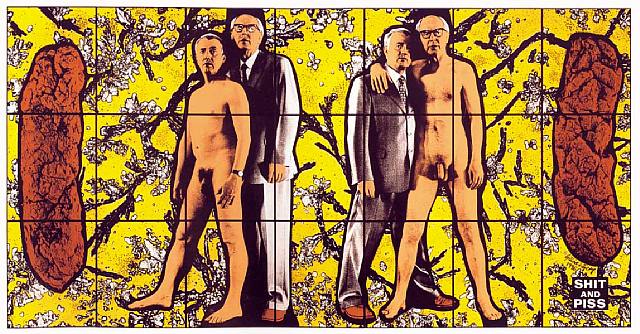Excerpts from a brilliant article exposing the underside of what Adorno called the “cultural industries” and what Kuspit refers to as art as part of the industrial entertainment complex so drowned and subsumed by money values there is strictly form absent from any redeeming values of integrity. Art stuck in a tar pit of high kitsch, a cultural marketing weapon at the service of narrow minded nationalism and the most parasitical elements of bourgeois values that can be corralled into the service of industry and finance.

Gilbert and George. ---...the number of perverts involved in the field of art is probably much greater than the average for the population in general.... It can be supposed ... that the pervert inclines in some particular manner to the world of art. Janine Chasseguet-Smirgel, Creativity and Perversion, 1985--- Image:http://www.all-art.org/art_20th_century/gilbert_george1.html
The basic theory is that our post-modern art produces the necessary cultural symbols, icons and overall narrative that entrench the social forms and values they serve to legitimate, usually hovering over the motherhood axioms of liberty as the most important goal of the individual, but to enter this egotistical world, the mechanical pedantry of a Russell or Hume, you have to adhere to Western cultural canons of the most conservative corporate ideology through, for the masses, the abstract world of materialist hope and faith hoping your number will come up on the lottery. One day.

---This is why so much modern art is kitsch -- innovative, avant-garde kitsch, no doubt, but kitsch nonetheless. All regressively desublimated art tends toward kitsch, especially anally oriented art, excrement being the ultimate kitsch. Kitsch is the most perverse, depraved, evil kind of art, as Broch suggests. Its perversity involves a kind of emotional decadence -- entropic regression, one might say. It turns the spectator into a voyeur -- Manet's Olympia certainly does this -- which is to devalue looking. It is this devaluation which makes all kitsch art evil. --- Read More:http://www.artnet.com/magazine/features/kuspit/kuspit6-10-02.asp
Maybe its our addiction to high kitsch and pop culture where discredited social forms keep ingeniously being reinvented in shiny new packaging only to be replaced by new and improved versions of the same canned feces. Its a cultural nihilism, an aggressive parasite hollowing out core values from the inside, a seductive world of derivative physical abstractions, an egotistical and infantile world that represents a more sophisticated iteration of the Nazis’ scorched earth program. We seem to be spoon fed with the denial of a hybrid, that is, non white culture through the cuteness arts, in this case cuteness being synonymous with the superficial, as seen in the Mike Kelley’s , Paul McCarthy’s and their imitators.

---In May 1961, while he was living in Milan, Piero Manzoni produced ninety cans of Artist's Shit. Each was numbered on the lid 001 to 090. Tate's work is number 004. A label on each can, printed in Italian, English, French and German, identified the contents as '"Artist's Shit", contents 30gr net freshly preserved, produced and tinned in May 1961.' In December 1961 Manzoni wrote in a letter to the artist Ben Vautier: 'I should like all artists to sell their fingerprints, or else stage competitions to see who can draw the longest line or sell their shit in tins. The fingerprint is the only sign of the personality that can be accepted: if collectors want something intimate, really personal to the artist, there's the artist's own shit, that is really his.' ---Read More:http://www.tate.org.uk/servlet/ViewWork?cgroupid=999999961&workid=27330&tabview=text&texttype=10
( See link at end) : …One of the functions of totalitarian culture is to simultaneously mask and highlight the class exclusions of art by reaching out to the ‘masses’ and encouraging them to view certain cultural artefacts as windows into a ‘higher’ realm, where their inclusion as passive spectators is actually a mark of their exclusion from participation in ‘serious’ culture in any meaningful sense. Ford in Myth Making describes how the ‘origination and propagation of the Young British Artist (yBa) myth are firstly the responsibility of the contemporary arts establishment. The myth then becomes a feature of the mediation between the art world and a wider audience by the mass media.’…

---Picasso's perverse transformations of the female body, so that it looks somewhat less than ideal, and his perverse transformation of traditional representation in Cubism, which involves the fetishization of abstract forms as ends in themselves, and also his perverse transformations of such masterpieces as Velazquez's Las Meninas, making them look less perfect and masterful than art history declares them to be -- his transformations of Las Meninas also devalue the family as well as a fellow Spanish master to whom history has awarded the crown of art that Picasso wants exclusively for himself -- are perhaps the most consummate examples of devaluating perversion in action in modern art. --- Read More:http://www.stewarthomesociety.org/2art.html
…The yBa appeals to those who have made their money from pop and fashion precisely because such people are upwardly mobile and, along with the yBa, form part of a pincher attack on Europe aimed at re-establishing Anglo-American hegemony in culture….
…The cult of the personality is, of course, a central element in all totalitarian art. While both fascism and democracy are variants on the capitalist mode of economic organisation, the former adopts the political orator as its exalted embodiment of the ‘great man,’ while the latter opts for the artist. This distinction is crucial if one is to understand how the yBa is situated within the evolving discourse of totalitarian art. Had the ‘bright young things’ of the London gallery scene merely copied the cultural excesses of the Nazi era, their reactionary activities would have been ghettoised within the far-Right fringe. However, the critics who theorise the yBa understand that by transforming art into a secular religion, rather than a mere adjunct of the state, liberalism imposes its domination over the ‘masses’ far more effectively than National Socialism. The focus, especially in the mass media, must be on the artists rather than the artwork….Read More:http://www.stewarthomesociety.org/2art.html
…Now there is another element that is crucial to the success of totalitarian culture, and that is the factor of high kitsch. The words Stephen Crook uses to deal with the issue of fascism in his introduction to Theodor Adorno’s The Stars Down To Earth And Other Essays On The Irrational In Culture can very ‘profitably’ be applied to the yBa and the ‘critical’ apologists for those forms of totalitarian culture which have emerged within ‘democratic’ regimes: ‘While its effects might be deadly, fascist propaganda is not altogether “serious”… The audience who turn out to see and hear the fascist agitator expect a good show… Their “sentimentality, blatant insincerity and phoniness” are not flaws in such performances, but the core of their appeal. The showman-like fakery of the agitator links him to the snake-oil salesman, the circus performer and an entire tradition of sentimentality and false tones”… Even more than their originals, recent European fascisms are highly syncretic. German fascist youths parade in the costumes of British skinheads while carrying banners which imitate the swastik
ag: theirs is a pastiche of fascism, but none the less dangerous for that.’…And, perhaps Donald Kuspit was correct after all in asserting that Marcel Duchamp was a major disruptive figure in art, a high priest of nihilism and a “terrorist” , the deep conceptualization of the gendered gaze, patriarchy and the echoing glorification of a non-existant world artificially fabricated for mass consumption and one dependent on an almost slavish relationship to our institutional structures as inviolate temples. If Ben Bernanke did a stress test on serious western culture, it would be declared insolvent beyond any measures of quantitative easings of piss and shit that a Gilbert and George could squeeze forth.
…One should not be surprised by the discrepancy between the high minded ideals ‘traditionally’ associated with art, and the subject matter that attracts totalitarian artists working under ‘liberal’ political conditions. Gilbert & George have their pictures of shit, just as Damien Hirst has worked with maggots. These serve to illustrate the gulf between art and life, a gulf which the totalitarian artist wishes to reinforce, whether it be through the idealised depiction of a Hitler or Mao, or by the use of subject matter drawn from everyday life, which ceases to be ordinary after undergoing an ‘alchemical’ transformation through the medium of art. In fact, such discrepancies serve the totalitarian artist very well, since those who support work of this type expect blatant insincerity. Nevertheless, while Damien Hirst might be rated the sixth most irritating man in the world by GQ Magazine, hacks of this type only provide the main focus of attack for those who wish to strengthen, rather than undermine, the institution of art. Hirst, Bank, Gavin Turk et al are interchangeable in their irrelevance, an expert such as Roberts is quick to praise their ‘thinking stupidity’ precisely because there is no danger of this crop of artists usurping the role of the critic by superseding art with philosophy…. Read More:http://www.stewarthomesociety.org/2art.html
ADDENDUM:
Do not necessarily agree with Caudwell, but sometimes he touched on some fundamentals that are worth examining though the context of industrial age capitalism is less significant today:
Christopher Caudwell, 1938:But the opposite is the case with the unfree, with the proletariat. The day they go in search of liberty, they revolt. The bourgeois, fighting for his liberty, must necessarily find himself in antagonism to the non-bourgeois, also fighting for liberty. The eventual issue of this struggle is due to the fact that capitalist economy, as it develops, makes ever narrower the class which really owns liberty until the day comes when the intellectual, the doctor, the petty bourgeois, the clerk, and the peasant, realise that they too are not after all free. And they see that the fight of the proletariat is their fight.
What, to the proletarian, is liberty – the extermination of those bourgeois institutions and relations which hold them in captivity – is necessarily compulsion and restraint to the bourgeois, just as the old bourgeois liberty generated non-liberty for the worker. The two notions of liberty are irreconcilable. Once the proletariat is in power, all attempts to re-establish bourgeois social relations will be attacks on proletarian liberty, and will therefore be repulsed as fiercely as men repulse all attacks on their liberty. This is the meaning of the dictatorship of the proletariat, and why with it there is censorship, ideological acerbity, and all the other devices developed by the bourgeois in the evolution of the coercive State which secures his freedom.
There is, however, one vital difference. Bourgeois social relations, generating the liberty of the bourgeois and the non-liberty of the proletarian, depend on the existence of both freedom and unfreedom for their continuance. The bourgeois would not enjoy his idleness without the labour of the worker, nor the worker remain in a bourgeois relationship without the coercive guidance and leadership of the bourgeois. Thus the liberty of the few is, in bourgeois social relations, built on the unfreedom of the many. The two notions dwell in perpetual antagonism. Read More:http://www.marxists.org/archive/caudwell/1938/liberty.htm





 COMMENTS
COMMENTS